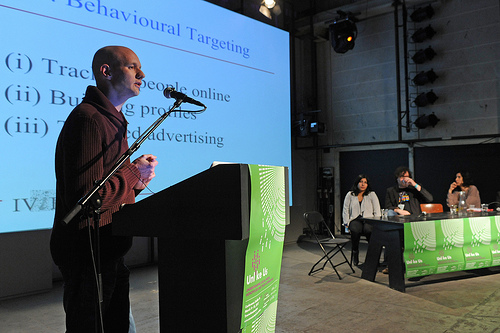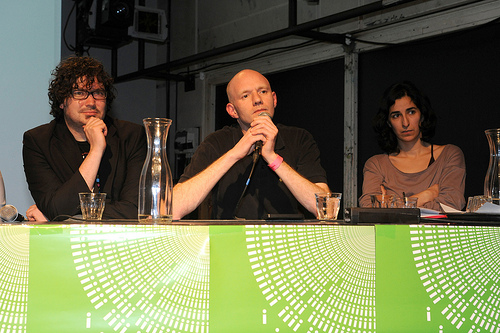 In session three ‘The Private in the Public’ of the UnlikeUs #2 conference, Frederik Zuiderveen Borgesius gave a very clear talk on ‘The Ecosystem of Online Audience Buying’.
In session three ‘The Private in the Public’ of the UnlikeUs #2 conference, Frederik Zuiderveen Borgesius gave a very clear talk on ‘The Ecosystem of Online Audience Buying’.
The example Zuiderveen Borgesius used to visualize the workings of online audience buying was that of a set of dresses that he had ‘put’ in an online shopping basket on a clothing site, to find that these dresses would haunt him for the next two weeks, popping up as advertising on a host of unrelated websites, reminding him of the cute frocks that would make him the star of this early springtime. To get behind the black box and unpack the mechanism of this phenomenon, the speaker split up the topic in two related parts: behavioral targeting and audience buying.
(Click here for the video of Frederik Zuiderveen Borgesius’ presentation)
Zuiderveen Borgesius then started with an introduction on behavioral targeting. He described it as the monitoring of online behaviour of internet users over time, in order to build a profile of these users, to target them with advertising matching their inferred interests. These profiles can get increasingly detailed.
This profiling online is successful, yet tedious, and it is here where the importance of social media becomes apparent. Here the stakes are not only higher: as all parts of social interaction can be observed and profiles can be mended to a very high degree of nuance, but at the same time this self-created data in a fully private online environment is handed over by the users voluntarily. Social media derive income directly from offering advertising space, and some also sell user data to third parties, who themselves are in ‘audience selling’. An example is Audience Science, a company that uses a its very own audience targeting table of segments to pin point user profile’s value for certain advertisers.
 The second part of the presentation concentrated on audience buying and this is where Zuiderveen Borgesius indicated that the complexity sky-rocketed. With the user profiles in the hands of advertising companies and the like, these can be made to profit when a user then visits a website where a banner ad is included in the design.
The second part of the presentation concentrated on audience buying and this is where Zuiderveen Borgesius indicated that the complexity sky-rocketed. With the user profiles in the hands of advertising companies and the like, these can be made to profit when a user then visits a website where a banner ad is included in the design.
Your website visit sets off an ad exchange. The website publisher will indicate to interested parties (advertising agencies) that there is an empty spot for an advertisment (‘black hole’) to be auctioned off, and in real time on a fully automated basis, the value of the user profile is inferred by all the different parties and bids are put in place based on how much they believe is to be gained from presenting this user (male, academic, living in an upmarket area, interested in dresses) with their particular ad. The winner gets to place the ad and that is what is visible to the end user, once again presented with that pretty little dress next to his morning news online. All this happens within 75 milliseconds.
The speaker declared to be amazed by the intricacy of this mechanism, especially when the end return of people actually clicking on the ad is only heightened from two per mille to three per mille. The market seems currently quite unregulated and hundreds of parties are involved, analyzing, repacking data, selling profiles, tweaking advertising placement, and reselling improved profiles. Being referred to by parties in the industry as ‘the wild west’, Zuiderveen Borgesius noted that intensive research energy should be devoted to the phenomenon to fully grasp the challenges that the judicial field faces here.


